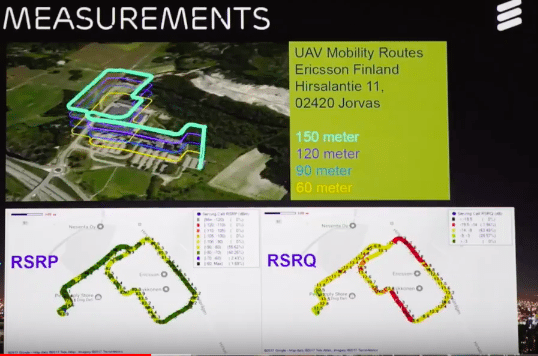Unmanned aerial vehicles, or drones, are shooting movies, spraying crops, delivering pizza, and performing dozens of other jobs across many industries. For mobile network operators, this could represent a major opportunity, and radio equipment vendors want to be ready.
“With new applications every day, I think this is a potential business opportunity for mobile operators,” said Xingqin Lin, wireless researcher and 3GPP delegate at Ericsson Labs. “Mobile networks stand ready for authenticating, monitoring and controlling these UAVs by providing wide area connectivity and also helping with UAV identification and registration.”
Drones present challenges to existing LTE networks, Lin said. In the air, interference is higher and resource utilization is lower than it is on the ground.
On cell towers, base station antennas tilt down, so drones that fly above the height of the tower are automatically at a disadvantage. In addition, drones may face more interference than ground-based devices, Lin said.
“Compared to terrestrial propagation, propagation in the sky is more close to line-of-sight free space propagation,” Lin said. So a UAV may receive more interference from neighboring base stations than a smartphone would, and it may also interfere with neighboring base stations when it transmits data back to the closest tower.
At the Texas Wireless Summit at the University of Texas, Lin showed results of tests Ericsson has conducted with drones flying at different heights. He showed the signal to noise ratios and the downlink coupling gain distributions at ground level, at 40 meters (five meters above the base station antenna) and at 120 meters, which is close to the highest altitude allowed for drones by the Federal Aviation Administration. SINR was always higher for the ground-based equipment, but downlink coupling gain was sometimes higher for the drones. Downlink coupling gain is antenna gain plus channel gain. Lin said antenna gain was always higher for the ground-based equipment, but channel gain helped make up for that with the drones because of line-of-sight propagation.
Overall, Lin said signal quality is less consistent in the air than it is on the ground, because of antenna downtilt and interference. Nonetheless, he believes existing LTE networks can support drones, and the outlook will only get better as next-generation technology rolls out.
“With performance-enhancing technologies and 5G, we can provide more efficient connectivity for UAVs,” Lin said.
Follow me on Twitter.

